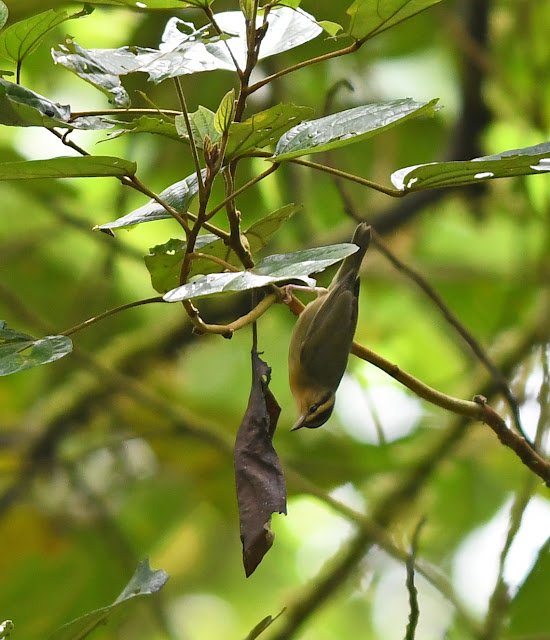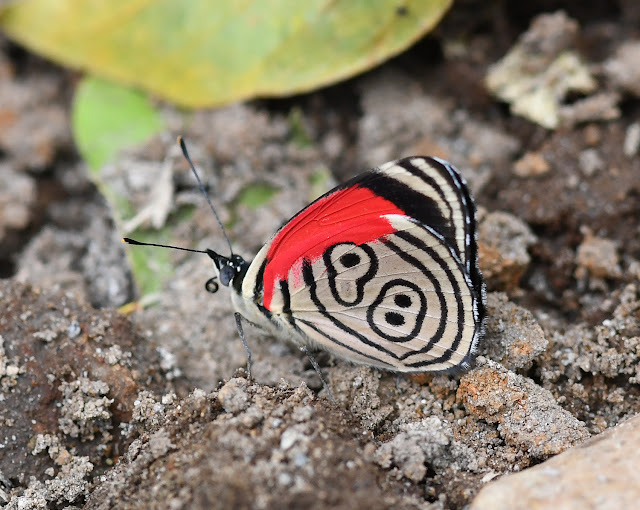Most foreign birders who travel to the province of Chiriquí in western Panama do so to search for particular species. Those are, of course, the regional specialties (shared with Costa Rica) that reside high up in the mountains, birds like Volcano Hummingbird, Silvery-throated Jay, Long-tailed Silky-Flycatcher, Costa Rican Pygmy-Owl, and the Costa Rican subspecies of Resplendent Quetzal, just to name a few of the many mouthwatering possibilities. Many of these birders visit either the Boquete side or Volcán side of Volcán Barú, two areas with excellent hiking trails and birding opportunities. But there is much more to this region of Panama than the highland birding. With today's post I wanted to highlight a birding hotspot that receives far less notoriety than the famous highland destinations. That locale is known as Las Lagunas de Volcán, or the Volcán Lakes.
 |
| Black-chested Jay - Lagunas de Volcán, Chiriquí, Panama |
Laura and I spent three nights in Boquete and three nights in Cerro Punta (above Volcán), taking advantage of the wonderful highland birding. But with most of our targets acquired and with some time on our hands, we decided to visit the Volcán Lakes to see what they were all about.
 |
| Turkey Vulture - Lagunas de Volcán, Chiriquí, Panama |
The Volcán Lakes are located within an ancient volcano crater, and at approximately 1350 m in elevation are some of the highest wetlands in Panama. To reach them, travel to the town of Volcán, and head southwest towards the airstrip which is around 3 km out of town. From here, a rough gravel track heads westwards towards the lake, passing by several horse farms along the way. Laura and I parked at the airstrip and walked down the gravel track since the birding can be very good along here. After perhaps 1 km or a little more, there is a welcome sign, and the track splits. If you continue straight, the track continues to the north side of the lakes, while if you turn left, it leads to the south side. Note that the lakes are only visible from the south side, but the birding is excellent along the north side as well. If you do choose to drive in, go no further than the above-mentioned fork in the road since both tracks deteriorate quite quickly.
That being said, regular hiking boots were sufficient during our visits. There are some muddy spots (like the scene pictured above), but they are easy to walk around. Most areas are largely mud-free, like pictured below.
Laura and I visited on October 5 for a couple hours in the afternoon and were quite surprised with how good the birding was, despite the time of day. It was so enjoyable that we never even made it past the first stretch of forest!
 |
| Blue-headed Parrots - Lagunas de Volcán, Chiriquí, Panama |
Migrant warblers were quite common and it was fun picking through them all. Our biggest highlight was a rarity for Panama. A male Connecticut Warbler hopped up out of the trailside vegetation, sat in view for a few seconds, and then flew back down. We both got it in our binoculars and I was pretty surprised to see the complete white eye ring, fully expecting it to be another Mourning Warbler! I tried following it and managed a few more partial views a little further down the track, but it unfortunately eluded my camera.
A slim, long-tailed raptor flew past and perched within sight, near the main fork in the road that I mentioned above. I first thought it was a forest-falcon, but we soon clued in that it was actually a young Bicolored Hawk. It allowed us to take many photos (and some audio recordings) before it flew out of sight. Another quality species!
 |
| Bicolored Hawk - Lagunas de Volcán, Chiriquí, Panama |
 |
| Bicolored Hawk - Lagunas de Volcán, Chiriquí, Panama |
Other highlights during our afternoon visit included Acadian, Alder and Fork-tailed Flycatchers and heard-only Fiery-billed Araçari and Spotted Wood-Quail. An excellent way to spend a few hours in the afternoon.
 |
| Yellow-headed Caracara pretending to be a Cattle Egret - Lagunas de Volcán, Chiriquí, Panama |
From a birding perspective, the lakes and surrounding forest are home to a number of specialty species. These include several regional endemics shared with the Pacific lowlands of Costa Rica including Fiery-billed Araçari, Chiriquí Foliage-gleaner and Costa Rican Brushfinch. The Chiriquí subspecies of Olive-crowned Yellowthroat nests along the marshy edges of the lakes, which are in turn home to Northern Jacana, American Coot, Pied-billed Grebe, and various duck, gallinule, kingfisher and heron species. The surrounding forests can provide excellent mixed flock birding and diversity is high at this elevation. And finally, we found the whole area fantastic for seeking out migrant species - tons of warblers and flycatchers abound at this time of year.
Laura and I had a later start to our birding day on October 6, pulling up to the airstrip just before 8 AM. Lucky for us, the sky remained clouded over for the entire morning, extending the good birding hours until late morning. As we walked along the entrance road, Mistletoe Tyrannulets made their presence known vocally. This species would be heard frequently throughout the whole morning.
 |
| Mistletoe Tyrannulet - Lagunas de Volcán, Chiriquí, Panama |
The first stretch of gravel track passes through pasture, lightly grazed by cattle. Wet ditches and occasional shrubbery provide some habitat for birds. Various flycatchers and migrant warblers caused us to stop frequently, while the soundtrack was provided by Rufous-collared Sparrows, Eastern Meadowlarks and Pale-breasted Spinetails.
 |
| Pale-breasted Spinetail - Lagunas de Volcán, Chiriquí, Panama |
 |
| Eastern Meadowlark - Lagunas de Volcán, Chiriquí, Panama |
 |
| Cattle Egrets - Lagunas de Volcán, Chiriquí, Panama |
A Roadside Hawk perched on the moss-laden trees, a beautiful scene with the mist in the background.
 |
| Roadside Hawk - Lagunas de Volcán, Chiriquí, Panama |
We were already past 50 species of birds by the time that we entered the first stretches of forest. And the mixed flock birding was pretty impressive. Our first mixed flock contained Chiriqui Foliage-gleaner, Orange-billed Sparrow, Red-crowned Ant-Tanager, Gray-headed Tanager, Streaked Saltator, Black-chested Jay, and quite a few others.
Warblers in particular stole the show. We noted 18 species including beauties like Ovenbird, Louisiana Waterthrush, Golden-winged Warbler and Laura's first ever Worm-eating Warbler (her Bird Of The Day). At one point I was about 80% sure that I saw a Prairie Warbler (a rarity in this part of Panama), but it disappeared before I could confirm. The many migrant species were augmented by residents including Golden-crowned Warbler, Gray-crowned Yellowthroat, Chestnut-capped Warbler and Slate-throated Redstart.
 |
| Golden-winged Warbler - Lagunas de Volcán, Chiriquí, Panama |
 |
| Worm-eating Warbler - Lagunas de Volcán, Chiriquí, Panama |
My "bird of the day" happened to be Costa Rica Brushfinch. We encountered two small groups of them along the north side of the first lake.
 |
| Costa Rican Brushfinch - Lagunas de Volcán, Chiriquí, Panama |
The forest birding continued to impress, with species like Olivaceous Woodcreeper and Olivaceous Piculet, White-winged Becard, White-throated Spadebill, Crested Guan, Eye-ringed Flatbill, Plain Antvireo, Green Honeycreeper and White-naped Brushfinch. By the time that we finally reached the lake for a rest break and early lunch, our species list was over 100 for the day.
 |
| Boat-billed Flycatcher - Lagunas de Volcán, Chiriquí, Panama |
 |
| White-throated Thrush - Lagunas de Volcán, Chiriquí, Panama |
The first lake has a few access points where one can scan for birds and wildlife, and it also has the better habitat, especially in the southwestern portion. Extensive marshy areas are home to gallinules and American Coots, various kingfishers (we noted Green and Ringed), White-throated Crakes, Northern Jacanas and more. The Chiriquí subspecies of Olive-crowned Yellowthroat breeds in these wetlands, though the only one I noted was in a small marshy section in the second lake. A pair of Spotted Wood-Quails were skulking in this same area, just within the forest edge.
Masked Ducks can sometimes be found (we did not see any), while small numbers of migratory ducks from North America often overwinter here. The only ducks that we noted included a few dodgy looking Muscovy Ducks and a small flock of Blue-winged Teals.
 |
| Blue-winged Teals - Lagunas de Volcán, Chiriquí, Panama |
As the morning wore on the sun came out from behind the clouds. Bird activity diminished, but the butterflies really took off! Below are a few of the colourful insects that posed long enough for me to photograph.
 |
| Pseudatteria sp. - Lagunas de Volcán, Chiriquí, Panama |
 |
| Widespread Eighty-eight (Diaethria clymena) - Lagunas de Volcán, Chiriquí, Panama |
 |
| Navy Eighty-eight (Diaethria astala) - Lagunas de Volcán, Chiriquí, Panama |
With the sun giving way to angry looking storm clouds, Laura and I called it a day and hiked back out to the airstrip and our waiting car. We had totalled 116 species of birds, representing our highest number on one checklist so far this trip. We had an awesome time at Las Lagunas de Volcán and highly recommend them for birders or naturalists alike.








































